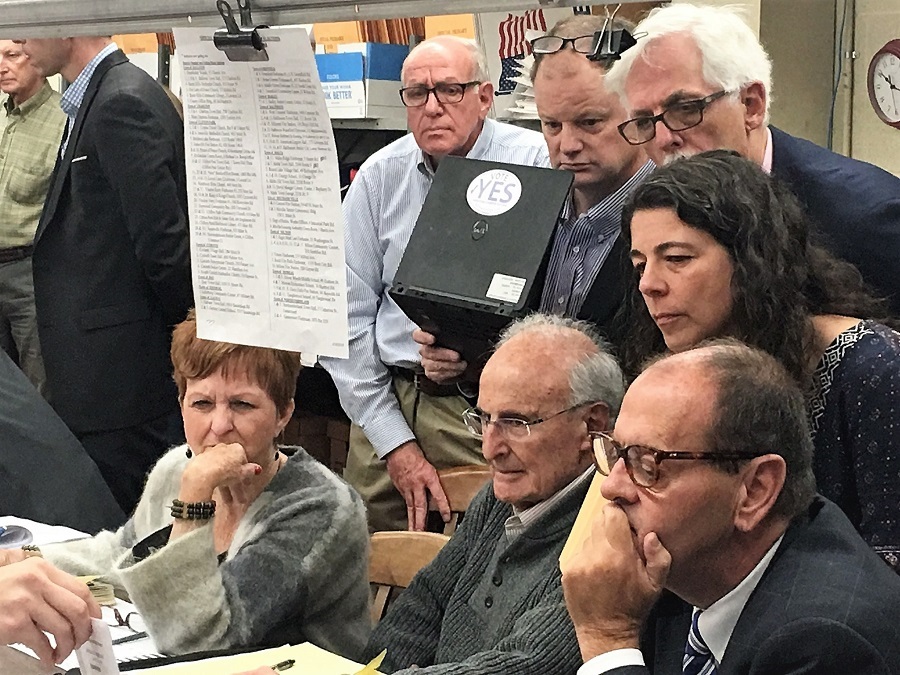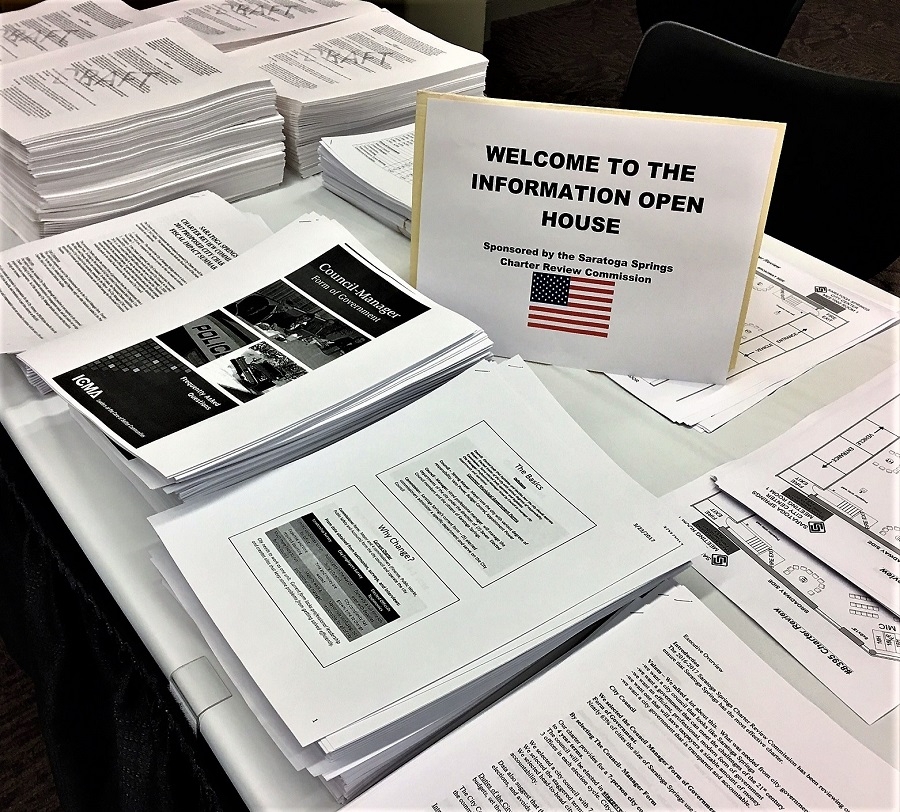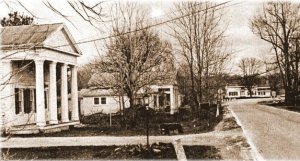Displaying items by tag: saratoga charter commission
Every Vote Counts: 10 Ballots Split the Difference Between Yes and No in City Charter Referendum
BALLSTON SPA – They descended on the village of Ballston Spa Tuesday – politicians and lawyers and election officials, members of the media and curious onlookers – on an unpredictable morning which gave no hint of the cold winter that will surely come, and no clue about how the prized chips of the day might fall.
All present crowded into a sub-level room at the county complex, Building Number Five. The “solar building,” as employees call it, was constructed atop land deeded to Saratoga County nearly 200 years ago by a New York City merchant named Nicholas Low for the development of a County Clerk’s office, assuring Ballston Spa would stand at the center of county government.
On this day, the 30-or-so people inside the building’s sub-level basement came to witness the opening and counting of approximately 550 absentee ballots. Some carried with them a cautious optimism to re-affirm the seat they’d won on Election Night remained secure, others with an angst-riddled hope that what they had lost might be regained. Most came to witness the counting of votes of the public referendum that could change the only form of governing the city of Saratoga Springs has known in its 102-year history.
The Election Night tally depicted a city divided and a race too close to call. Of the nearly 8,500 ballots cast, the difference was a measly 48 votes. There were 4,202 YES votes cast that urged Charter Change. There were 4,154 NO votes registered in favor of maintaining the status quo. The counting of the absentee ballots, most assumed, would settle the final score.
The current Commission form of governing relies on five elected part-time council members, each of whom are responsible for administering their own department, as well as serving as legislators. The proposed Council-Manager form of governing would see that the council hires a non-partisan, professional city manager to carry out city policies.

10:16 a.m.: The first handful of ballots are taken from their envelopes and displayed to watchers. Saratoga Springs District Two, Embury Apartments: Yes. No. Yes. No. No. Yes. No. No. Attorneys scrawl stick figures atop their legal pads. The No’s have gained two votes. The overall Yes lead of 48 drops to 46.
11 a.m.: More districts come in. The count: 18 Yes, 32 No. Overall Yes lead drops to 34.
12:30 a.m.: Break for lunch. The count on the day: Yes 128, No 161. Yes lead drops another 19 votes. Math update, overall: Yes 4,330, No 4,315. Overall Yes lead drops to 15. Fortified by sandwiches and fueled by caffeine, everyone returns from lunch and is moved upstairs to a bigger room. First up, one of the Senior Citizens Center’s voting districts. Result: 7 Yes, 14 No. Overall: 4,337 to 4,329. Yes lead up by eight.
2:02 p.m.: Saratoga Springs High School Gym voting district - 10 Yes, 17 No. Overall: 4,347 to 4,346. Yes clings to the lead by one vote. Stress begins to show on the some of the faces in the room.
2:15 p.m.: City Center voting district: Yes 24, No 18. Yes back up by seven. Deep breaths on all sides. Over the next half hour, voting districts at United Methodist Church, a second Senior Citizens Center, and the Interlaken Community Center are presented, collectively giving the No count 18 additional votes, and the lead. The room loses its mind. There are some audible noises. Whether these are cries of joy, or cries of pain are difficult to determine. At this point, it’s hard to tell the difference.
3 p.m.: The mailman arrives. An election commissioner is dispatched to meet the mail carrier to learn if any last-minute absentee ballots have arrived on this, the deadline day. Inside the room, the counting continues of ballots from the city’s two final districts. And then it is over. The No votes have it, by seven.
But, wait, suddenly five more ballots are presented. These were set aside during the course of the day’s counting, one of the election officials explains.

“It ain’t over til it’s over, and it ain’t over yet,” says Richard Sellers, a spokesman for SUCCESS, a citizen organization that supports maintaining the current form of governing. “It feels a lot better to be up by seven than down by 48, or whatever it was a week ago (but) “I’ll celebrate when they tell me it’s over.”
“It’s a squeaker,” says Charter Review Commissioner Treasurer Gordon Boyd. The commission, which officially disbanded when the polls closed Election Night, conducted 16 months of study, staged dozens of public meetings and voted to pursue the possibility of Charter Change and adopt a council-manager form of governing. A decade ago, Boyd was a member of the SUCCESS group. This time he is part of the pro-change group. In the exploration of Charter alternatives, some residents have changed their minds over time and party lines crossed, making it all the more difficult to gauge which way the majority will go.
Adding to the unpredictability, the members of the City Council have also taken sides - this despite the words of state Board of Elections attorney Brian Quail, who said advocacy by a municipality on a referendum question is unlawful, and that a municipality hiring counsel to participate in a canvas conducted by the Board of Elections is, in his 16 years of experience, unprecedented.
Twenty-four hours earlier, City Council members John Franck, Michele Madigan and Anthony “Skip” Scirocco – each of whom have spoken in favor of maintaining the current form of governing, approved by a 3-0 vote the hiring of a Glens Falls attorney and an associate attorney at the combined rate of $525 per hour to observe Tuesday's event and “defend the city’s right to have all proper absentee ballots counted.” The two council members who have spoken in favor of changing the form of governing, Mayor Joanne Yepsen and Commissioner Chris Mathiesen, did not attend Monday’s “Special” City Council meeting. John Aspland, the main attorney hired to observe the absentee ballot count does just that, occasionally inking notes on a legal pad throughout the day.

Those last five ballots, the “set-asides,”are presented. Two are ruled invalid. The other three are held up, one at a time: No, no, and…no.
The unofficially tally stands at 4,458 No, 4,448 Yes. It is a calculation that would require the re-beading of an abacus: 50.06141926 percent No, 49.943858073 percent Yes. Approximately half the city’s eligible 18,000 voters took part in the vote.
“The absentee ballots came in strong just as they did in 2012 when the Commission form of government beat down a challenge,” Sellers says.
The 2012 vote which proposed amending the Charter and replacing the Commission form of government with a Manager-Council form resulted in 6,738 - 4,872 No victory, a 58-42 percent difference. A referendum in 2006 proposing a change to a strong-mayor form of government was voted down 5865-3615, roughly a 62-38 difference. Counting this year’s referendum, the margin of differences have grown smaller with each successive vote.
“I don’t think the issue of the form of government in Saratoga Springs is going to go away any time soon,” a disappointed Boyd says. “But I think we have a lot to be proud of, a lot to build on. This was a people’s campaign. We had the forces of both political party leaderships and the government of Saratoga (springs) mobilized against this proposal and we fought them pretty much to a draw.”
Eighteen Military Ballots were requested, as of this week, none have been returned. They must be received by the Board of Elections by Monday, Nov. 20 to be counted, and indications are any which do arrive will be counted Tuesday, Nov. 21.
Boyd was asked whether the referendum vote could be headed for the courtroom. “I don’t know. I just don’t know,” he responds. “We want to be sure that every valid vote has been counted.”
Bob Turner, who served as chairman of the Saratoga Springs City Charter Review Commission, said there are currently conversations being had regarding “overvotes,” which occurs when one votes for more than the maximum number of selections allowed in a contest. Turner said he doesn’t know the specific number of overvotes that appeared on voter’s ballots, but the incident could occur when voters hand write-in candidates on the front of the ballot and inked traces appear as multiple markings appear on the ballot’s reverse side, which is where Charter Change proposition question was printed.
“We’re exploring the processes. That could lead to a hand count of all 8,000-something ballots,” Turner said. That decision whether to pursue the matter could come early next week. The ballot numbers remain unofficial until they are certified by the Board of Elections. That process is anticipated to take at least a few weeks.
Commission Releases Proposed Charter Draft; Referendum in November
SARATOGA SPRINGS – The final draft of the proposed Saratoga Springs Charter was distributed Tuesday afternoon at the City Center, where members of the Charter Review Commission staged a daylong informational Open House. A referendum on the proposed changes of the way the city is governed will be on the November ballot.
The proposal calls for a change from the current “Commission” form of governing – the only form the city has known since its inception in 1915 – to a “council-manager” form, which is the most popular and most efficient form in the country, according to charter review member Pat Kane.
The council-manager structure specifies a composition of six councilmembers and one mayor – all electable positions – and one city manager, who would be hired by the council.
The city manager would direct and supervise administration of all departments, appoint and suspend or remove city employees, and prepare and submit the annual comprehensive budget and capital program plan to the council for approval.
The city manager would also represent the city in the collective bargaining process, as well as implement contracts on behalf of the council, and attend all council meetings, but will not cast a vote at the seven-member council table. The mayor would be recognized as the head of city government for ceremonial purposes, but have no administrative duties. Council meetings would continue to be held twice a month.
“I think local municipal government has gotten far more complicated and really does scream out for professional management,” Kane said. “These people would come in with skills that we just don’t have from an elected official prospective. It also opens the door for the local city council, where anyone can run with no requirements as far as job skills are concerned. “
The council would serve as the legislative and policy-making body of the city, conduct the search, set the salary and oversee the hiring and appointment of a city manager. Prerequisites for the city manager ‘s positions include a master’s degree with a concentration in public administration, public affairs, or public policy, and five years of managerial or administrative experience in municipal government. The salary for the position is anticipated to be in the $125,000 per-year range – which is higher than any current council member or deputy earns annually. It would ultimately provide financial savings however, the commission says, because the five current deputy positions – each earning about $73,000 annually (about $110,000 annually when benefits are factored in) would be eliminated or altered and would serve “at the pleasure of the city manager.”
“Most people thought it would be a deficit, but this would be a significant savings,” said Kane said, adding that bringing a professional level of qualified management to the city would eliminate weaknesses in current checks and balances, and guarantee a less expensive city government. “The efficiencies jump out at you. It’s so much more efficient when you’re running with one team as opposed to five teams. “
Detractors aren’t so sure a change would provide a financial savings and are additionally leery about what they say will be create more difficulty in communicating grievances with City Hall.
“Now if you have a problem you pick up the phone and call the department head. If you don’t like the answer, well, they’re only in there for two years,” Jane Weihe told a group of three dozen area residents who gathered at Gaffney’s on May 30 for a get-together of the SUCCESS group. The acronym stands for: Saratogians United to Continue the Charter Essential for Saratoga's Success. Those assembled vowed to fight against charter change.
Weihe said a citizen with an issue in the council-manager form of governing would need to bring the issue to the city manager and if the response wasn’t acceptable it would create an intricate process to lobby the majority of the city council to remove the department head, which would come at a financial price.
“Two questions: Who are you going to call, and what’s it going to cost,” Weihe said. The removal of a city manager would come either at the request of the city council, or by their majority vote, and would require a public hearing.
The May 30 date is significant. It was initially the day the referendum vote was to be held. Commission members had said the standalone date would give the proposition the attention it deserved rather than becoming muddied in an already busy election season in November. Detractors of the plan alleged an off-peak election was an attempt to suppress voter turnout.
“I moved here over 40 years ago and dealt with many mayors and council members. I’ve seen the system at work – and it works,” Joe Dalton told the SUCCESS group.
“To say that that it ain’t broke is probably the biggest misconception out there,” countered Kane. “It may feel like we have a multitude of success – and we do – but we can do better. It’s like an upgrade in software. We’re operating at Windows 1.0 when we should be operating at Windows 10. We’re not changing services, we’re changing how the services inter-relate to one another,” he said.
How a Transition Would Work
Should the change be approved by voters this November, in November 2019 residents would elect a mayor and six councilmen and the change would be enacted Jan. 1, 2020. The mayor and the three council members receiving the greatest number of votes would serve four-year terms; the remaining three council members would serve two-year terms. This would eventually be adjusted to have separately contested elections with staggered four-year terms for each of the seven members. Term limits would be set at a maximum of 12 years.
Compensation for the six council members, the mayor, and the city manager – as well as that of a potential assistant city manager – would be designated by the outgoing council in 2018. Two elected supervisor positions would continue in a similar capacity, although would eventually increase to four-year electable terms.
The City Manager at Work
“The city manager is the CEO and responsible for the day-to-day operations of the city,” explained Sharon Addison, city manager of Watertown, N.Y., which has a similar population and annual budget to Saratoga Springs.
“The city council legislates, adopts local laws and resolutions and it’s my responsibility to execute on that,” she said. “We’ve got multiple department heads – similar I think to your commissioners – and I work very closely with the department heads to make sure the goals and objectives are accomplished in each of those departments.”
Paid position staff members that report directly to Addison include the fire chief and police chief, superintendents of the DPW and Parks and Recreation, a city engineer, library director, purchasing manager, and city assessor. Overall, Addison oversees more than a dozen different departments, each with their own independent budgets that are combined into the general fund budget.
Addison worked for more than a quarter-century at the National Security Agency in Fort Meade, Maryland, prior to becoming Watertown’s city manager in 2012.
“Leadership and management qualities are pivotal, as well as experience in financial management,” she said.
Saratoga Springs Residents to Vote May 30 on City Form of Governing
SARATOGA SPRINGS — If all goes according to plan, city residents will vote in a special election on May 30 that may alter the way Saratoga Springs has been governed since its incorporation as a city in 1915.
Plans call for a ballot providing voters with two options: keep the current City Charter and the commission form of governing as is, or revise the charter with a new form of governing. That proposed new form - the council-manager form of government, was approved by a 14-0 vote by the Commission late Thursday.
The Commission has staged meetings and conducted interviews and surveys during the past seven months. Among its recommendations are increasing the number of council members from five to seven, their terms from two years to four years, and putting a system in place to ensure members come from all corners of the city.
“There’s no magic number, but we felt seven was the right number and it’s also the average number of members in councils across the country,” Charter Review Commission chairman Bob Turner told the City Council on Tuesday. Additionally, the proposed four-year terms – similar to approximately 70 percent of city governments in America - would reduce the frequency of fundraising and campaigning, Turner said.
The commission’s lengthiest discussion concerned the merits of neighborhood districts versus at-large elections. Under the current system, commissioners are elected in city-wide elections. Under a neighborhood district system, council members are elected from a neighborhood or smaller geographic area. Candidates would have to live in the district they represent. Neighborhood districts would make a positive contribution to the electoral and governance process of the city, according to the commission. Neighborhood districts would also make it easier for new candidates to run for office since they would only have to reach out to approximately 4,500 voters instead of 18,000. Commission studies indicate that the vast majority of City Council candidates during the past 15 years have come from a small cluster on the central east side of the city, and argue that neighborhood districts would ensure more geographic representation in City Council affairs.
The Commission also supported giving the City Council confirmation power over all mayoral appointments to city boards and judicial appointments pending state law.
The May 30 date is the last Tuesday that a special election can be held while also allowing new candidates to choose to run for the City Council in 2017, based on whether the charter referendum succeeds or fails.
“A special election in May also gives any candidates for public office the full picture of what the voters want for their form of government, one way or the other,” said commission member Gordon Boyd, in a statement.
What is the Council-Manager Form of Government?
Under the council-manager form of government, the city council approves the budget, determines the tax rate and focuses on the community’s goals, major projects, and such long-term considerations as community growth, land use development, capital improvement plans, capital financing, and strategic planning. The council hires a highly trained non-partisan, professional city manager to carry out these policies with an emphasis on effective, efficient, and equitable service delivery. Managers serve at the pleasure of the governing body and can be fired by a majority of the council.
The council-manager form is the most popular structure of local government in the United States. Among cities with a 25,000-49,999 population, 63 percent of cities have a council manager structure, 31 percent have mayor council, and 1% has the commission form of government. Currently, Saratoga Springs and Mechanicville are the only cities in New York that have the commission form of government, according to the Commission.
Pat Kane, vice-chairman of the 15-member citizen board, said he anticipates total costs to be about $46,000 - $20,000 for legal drafting costs, $20,000 for community information outreach, and about $6,000 in clerical support expense. Additionally, a special election would cost $37,000. There has been push-back among some current council members regarding the timing and the expense of a special election. Specifically, Commissioner John Franck contends that residents will be less likely to make the effort to vote in a special election than they would be in a more traditionally timed vote in November. Commissioner Chris Mathiesen countered that in November all five current council seats will be up for re-election and that adding a charter review vote would only serve to complicate matters and not allow the issue the appropriate focus it deserves.
The council has until late February to approve the request to fund the Commission’s expenses as well as the special election; if it fails to do so, it is believed the mayor has the ability to approve the amount of funding sought. Representatives of the Charter Commission met with members of the city finance department Wednesday, and it is anticipated the council will discuss the funding requests in the near future. The council’s next regularly scheduled meeting is Feb. 7, although a “special” council meeting to specifically discuss the matter may be called for prior to that date.






























 How to resolve AdBlock issue?
How to resolve AdBlock issue? 









